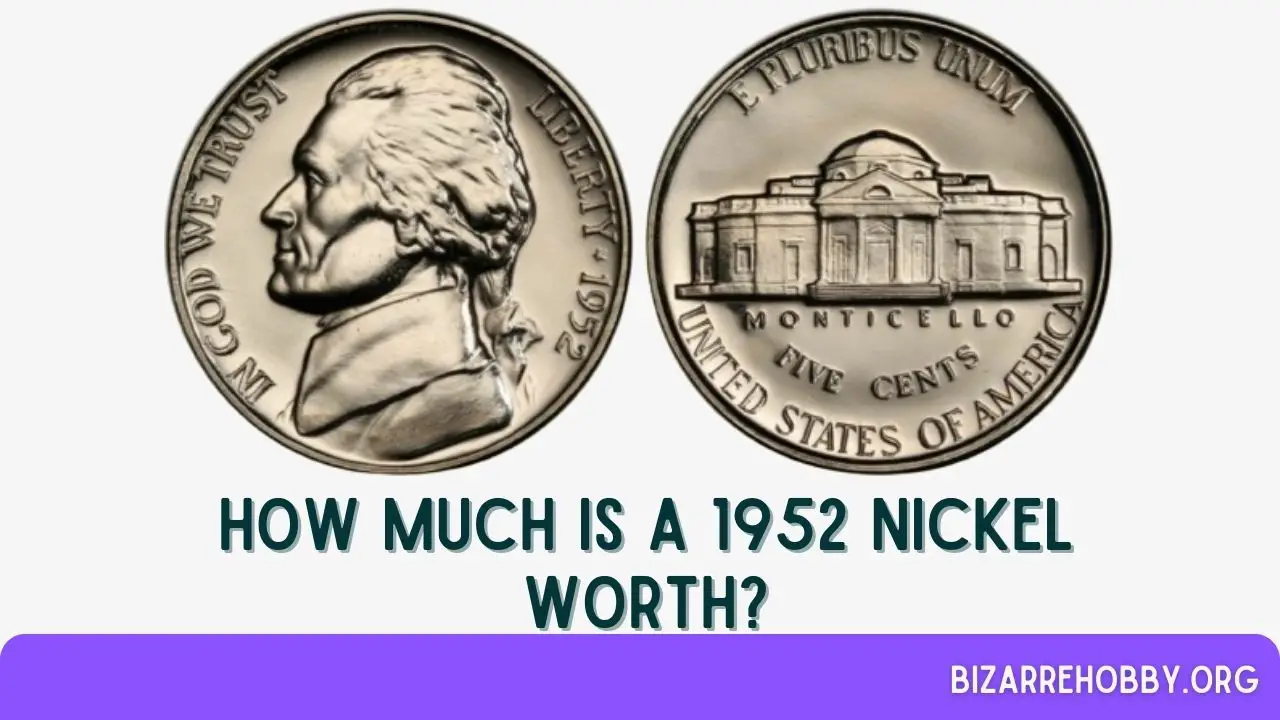The 1952 Nickel, a 5-cent American coin, is intriguingly composed of more copper than nickel. Its shiny silver appearance, however, earned it the nickname “Nickel.” This is significant because the original 5-cent coins were made of silver. When silver became too costly, the US Mint had to maintain the coin’s luxurious, silvery look. Let’s delve into the 1952 Nickel’s value and its historical context.
Table of Contents
- Value Chart for 1952 Nickel
- Historical Background of the 1952 Nickel
- Designs of the 1952 Nickel
- Grading Guide for 1952 Nickel
- 1952 Nickel Value Guide
- Rare 1952 Nickel Errors List
- 1952 [P] Proof Nickel Re-engraved Obverse [FS-401 to FS-404]
- 1952-D Nickel Broad-struck Cleaned
- 1952 [P] Nickel Broken Planchet – 2 Pieces
- 1952 [P] Nickel Double Struck 90% Off-Center
- 1952-S Nickel Struck 50% Off-Center
- 1952 [P] Nickel Struck on a Dime Planchet
- 1952 [P] Nickel Struck on a Penny Planchet
- 1952 Nickels Split After Strike – Two Pieces
- 1952 [P] Nickel Clamshell Lamination Error
- Where to Sell Your 1952 Nickel?
- What to look for in 1952 Nickel?
- FAQs On 1952 Nickel coin
- Final Thoughts
Value Chart for 1952 Nickel
| Coin | MS 63+ | MS 64+ | MS 65+ | MS 66+ | MS 67 | PR/PF 69 DCAM |
|---|---|---|---|---|---|---|
| 1952-D Nickel | $11 | $17 | $255 | $140 | $4255 | NA |
| 1952-D Nickel Full Steps | $65 | $135 | $165 | $850 | $5,850 | NA |
| 1952-S Nickel | $6 | $18 | $26 | $50 | $700 | NA |
| 1952-S Nickel Full Steps | $72 | $175 | $375 | $1,250 | $11,000 | NA |
| 1952 No Mint Mark Nickel | $9 | $18 | $35 | $165 | $1,050 | NA |
| 1952 (P) No Mint Mark Nickel Full Steps | $125 | $525 | $1,950 | $8,150 | NA | NA |
| 1952 (P) No Mint Mark Proof Nickel | NA | NA | NA | NA | NA | $11,750 |
Historical Background of the 1952 Nickel
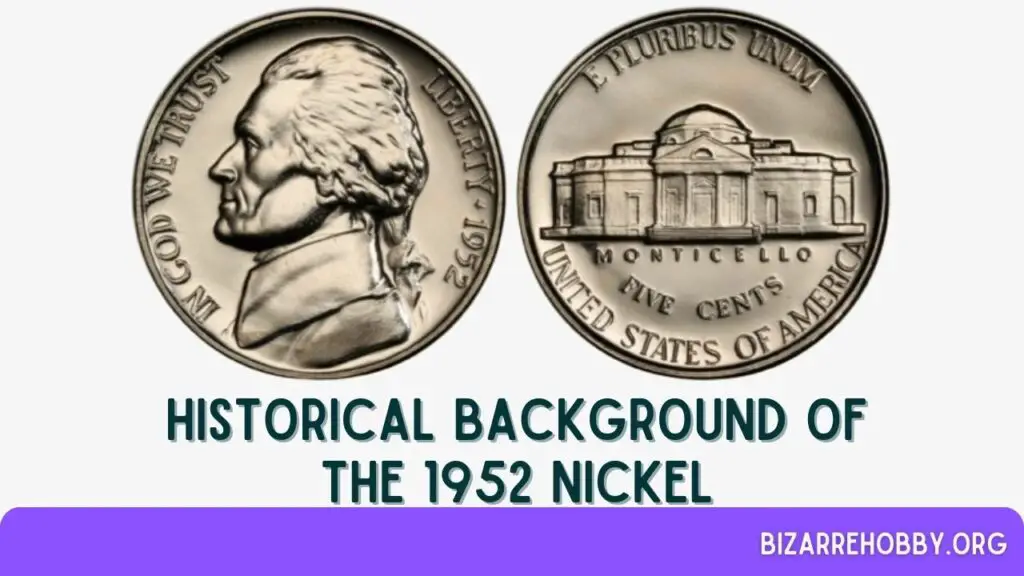
Initially, the 5-cent coin was known as a Half Dime (or Half Disme, with a silent ‘s’). This can be confusing since nickels are physically larger than dimes. The reason lies in the early days when coins were made from precious metals like silver and gold, known as specie metals.
Over time, US coins transitioned to base metals such as steel, zinc, nickel, and copper for various reasons. The Dime (10-cent coin) retained its silver content longer than the Half Dime, necessitating a smaller diameter to ensure its face value remained below its melt value—the market price of the silver in a melted coin.
Even today, despite both nickels and dimes being made from base metals, their sizes have remained unchanged. Interestingly, the nickel was the first legal tender to experiment with the alloy that eventually coated all US coins.
This alloy, consisting of 75% copper and 25% nickel, was introduced in 1866 and is still used in 5-cent coins today. It also forms the outer clad layer of other denominations.
Early US Nickel Coins Politics
The nickel was never meant to be a permanent fixture. Mint Director James Pollock introduced it temporarily to replace the 5-cent note. Pollock was not a fan of base metal money, but during wartime, precious metals were scarce, and regional paper money was easily forged due to lack of centralization.
The mint experimented with a 2-cent piece made of 95% copper from 1864 to 1873 and a silver 3-cent piece known as a trime from 1851 to 1873.
The 3-cent piece later changed to 75% copper and 25% nickel, serving as a case study that led to the 5-cent piece in the same base metal combination. Pollock believed these coins could serve until the nation returned to silver and gold currency.
However, nickel magnates lobbied for the continued use of nickel coins, and the public had already accepted them. From 1865 to 1889, the nickel 3-cent piece circulated widely.
When it no longer made financial sense, the 5-cent nickel—now commonly called the nickel—became the smallest silver-colored denomination, with only the 95% copper penny having a lower value.
The Unusual Design Details of the Jefferson Nickel
Among all circulating US coins, only the Jefferson Nickel has “United States of America” at the bottom of the tails side. On other coins, the country’s name is at the top. This design feature dates back to the coin’s inception in 1938 when designer Felix Oscar Schlag misplaced it. Although he was asked to correct it, the change was never made.
In 2004 and 2005, “United States of America” moved to the top of the tails side for the Westward Journey Series, which featured four distinct reverse designs to commemorate the Bicentennial of the Lewis and Clark Expedition. The 2005 coins also had a unique obverse design.
In 2006, the original reverse design was restored, complete with its bottom-based country name. This change was driven by Virginia Representative Eric Cantor, who wanted to ensure Monticello remained on the coin as an important state landmark.
He wrote a bill to guarantee the Monticello reverse would return after the Bicentennial Nickel redesign of 2004 and 2005.
Designs of the 1952 Nickel
Understanding the features of a coin involves some specific terminology. We’ve already discussed the obverse (front) and reverse (back), but let’s dive deeper. The thin side of the coin is known as the edge, while the raised border is called the rim or collar.
The images on the coin are referred to as devices, the inscriptions are mottos or legends, and the flat background is the field. Coins are created by striking blank discs, known as planchets, with dies.
Obverse Design of 1952 Nickel
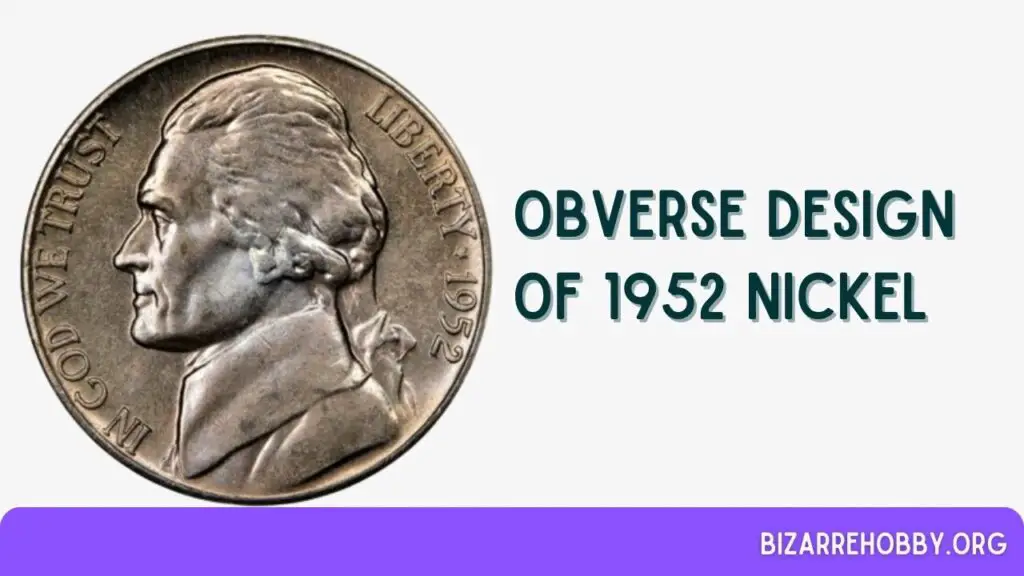
The obverse side of the 1952 Nickel features a portrait of Thomas Jefferson, the 3rd President of the United States. To the left of Jefferson’s image, you’ll find the motto “In God We Trust.”
Behind him, the word “Liberty” is inscribed, followed by a star and the year “1952.” Notably, the 1952 Nickel lacks the designer’s initials, which were only added in 1966. Additionally, there is no mint mark on the obverse side of this coin.
Reverse Design of 1952 Nickel
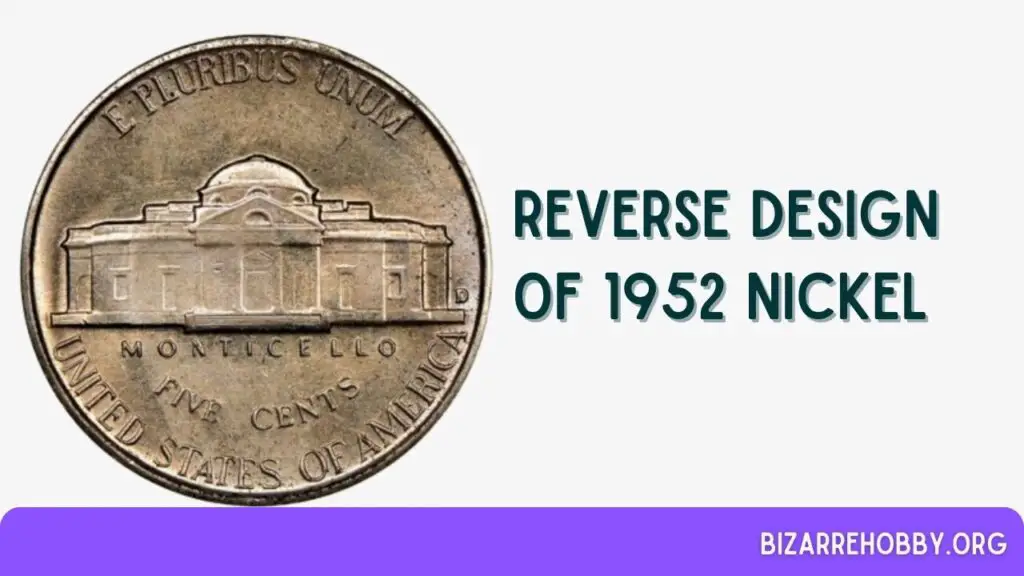
The reverse side showcases Monticello, Jefferson’s renowned estate in Virginia. Below the depiction of Monticello, the name of the mansion is inscribed, followed by the coin’s denomination, “Five Cents.”
Beneath this, the legend “United States of America” curves along the bottom. At the top of the coin, the motto “E Pluribus Unum” is displayed. The mint mark, if present, is located to the right of Monticello.
Technical Features of the 1952 Nickel
The 1952 Nickel is composed of 75% copper and 25% nickel. It has a diameter of 21.21mm and a thickness of 1.95mm, with a smooth, plain edge (lacking any reeds). The coin weighs 5 grams.
In addition to the standard Sheldon Scale grading, Jefferson Nickels are also evaluated based on the clarity of Monticello’s staircase. The most valuable coins are those graded as 5 FS (Full Steps) and 6 FS, indicating that the steps are fully visible and well-defined.
Grading Guide for 1952 Nickel
The terms 5FS and 6FS refer to the number of steps visible on the Monticello building on the reverse side of the Jefferson Nickel. Coins with these designations are considered premium because they exhibit clear, distinct steps.
Jefferson Nickels are graded on the Sheldon Scale, which ranges from 1 (Poor) to 70 (Mint State). Before opting for a professional appraisal, you can use online resources to get an initial idea of your coin’s grade.
| Sheldon Scale | Grade |
|---|---|
| 1 | Basal State-1 |
| 2 | Fair |
| 3 | Very Fair |
| 4, 5, 6 | Good |
| 7, 8, 10 | Very Good |
| 12, 15 | Fine |
| 20, 30 | Very Fine |
| 40 | Extremely Fine |
| 50 | About Uncirculated |
| 60 | Mint State |
| 65 | Mint State |
| 70 | Mint State |
For a detailed understanding of your coin’s grade, refer to our Jefferson Nickel comprehensive grading guides. Knowing the grade is crucial for determining the exact value of your 1952 Nickel.
1952 Nickel Value Guide
When assessing the value of a 1952 Nickel, the mint location is a key factor. In 1952, Jefferson Nickels were minted in Philadelphia, San Francisco, and Denver. Additionally, proof coins were produced in Philadelphia. Business strike coins are intended for general circulation, while proof coins are specifically made for collectors.
1952-D Nickel Value
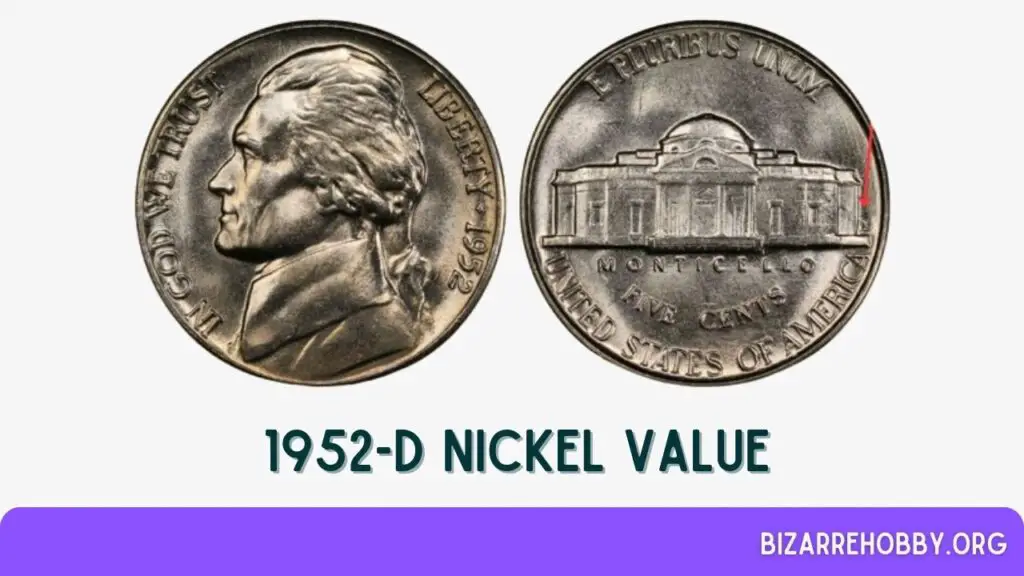
The Denver Mint produced 30,638,000 Nickels in 1952, all bearing the “D” mint mark. In 2006, an MS 67 grade coin sold for $1,093. This remains the highest known grade, but as of September 2023, the value has adjusted to $425, with nearly 15 such coins graded by PCGS.
Coins graded MS 66 are more common, with over 400 known, and are valued at $28. An MS 67 FS (Full Steps) coin, which sold for $16,450 in 2015, is now worth $5,850, with only 7 known examples.
1952-S Nickel Value
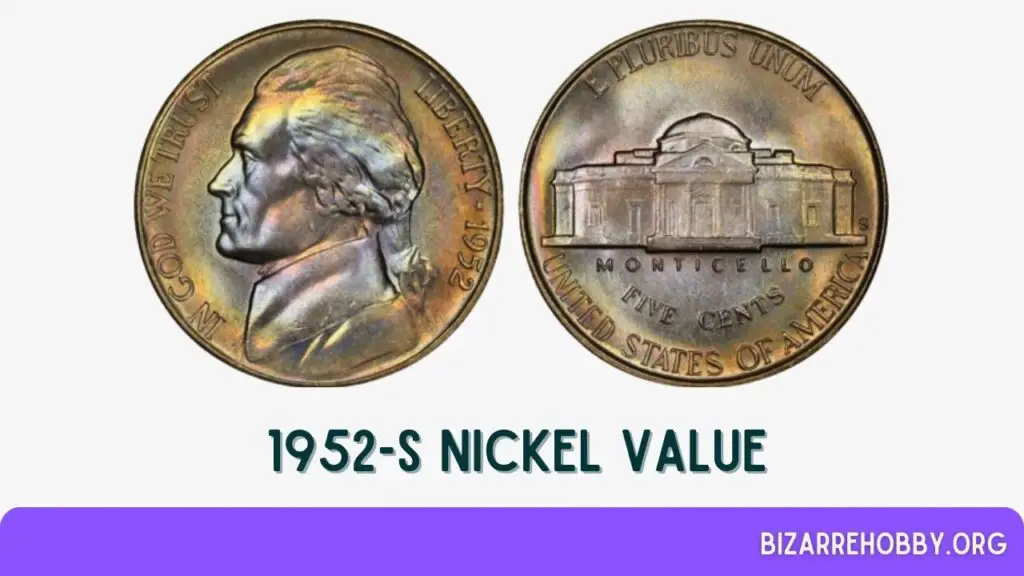
In 1952, the San Francisco Mint produced 20,572,000 Nickels, all marked with an “S”. An MS 67 coin sold for $845 on eBay in June 2023, leading PCGS to estimate the value of the 7 known coins at $700.
An MS 66 FS coin, which sold for $9,488 in 2007, is now valued at $900, with nearly 60 known examples. An MS 66+ FS coin is worth $1,250, while an MS 67 FS is valued at $11,000.
1952 No Mint Mark Nickel Value
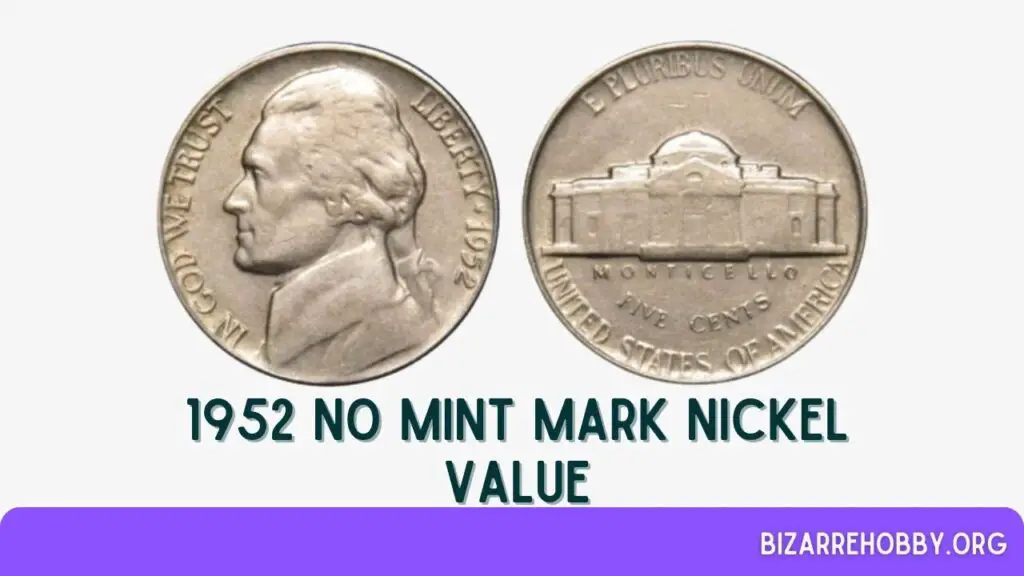
The Philadelphia Mint produced 63,988,000 Nickels in 1952, which do not bear a mint mark. An MS 67+ coin sold for $3,995 in June 2016, but its value has decreased to $1,800 as of September 2023.
An MS 66 FS coin, which sold for $9,400 in August 2012, is now valued at $2,850, with ten known examples. An MS 66+ FS coin is valued at $8,150.
1952 [P] Proof No Mint Mark Nickel Value
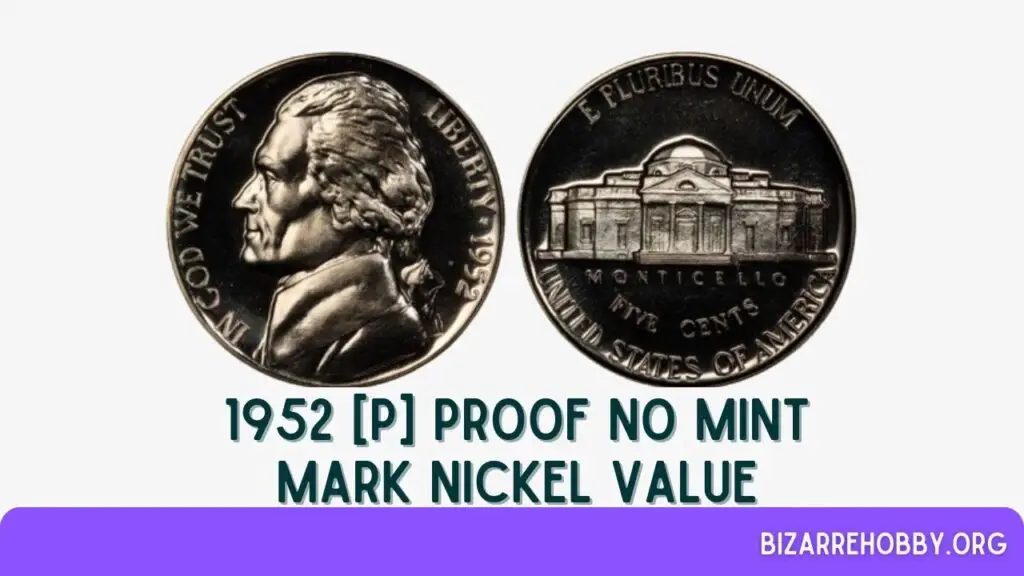
Proof coins are struck with special dies to achieve a mirror-like finish. The Philadelphia Mint produced 81,980 proof Nickels in 1952, which do not bear a mint mark. These coins are treated with acid and horsehair to create a contrast between the raised design and the flat background.
The highest quality proof coins are graded Deep Cameo (DCAM) or Ultra Cameo, followed by Cameo.
In 2018, a PR 69 proof coin sold for $1,200 and is now valued at $1,500. A PR 68 CAM coin, which sold for $2,585 in 2013, is now worth $500. A PR 68 DCAM coin, which sold for $14,950 in 2010, is now valued at $4,600. A PR 69 DCAM coin is valued at $11,750.
Rare 1952 Nickel Errors List
The abbreviation FS on Jefferson Nickels can signify three different things: Full Steps, Felix Schlag (the coin’s designer), or First Strike, which refers to mint errors identified within the first 30 days of a coin’s release.
FS errors are typically more valuable than those discovered later. Let’s delve into some notable 1952 Nickel errors, including FS-401 to FS-404.
1952 [P] Proof Nickel Re-engraved Obverse [FS-401 to FS-404]
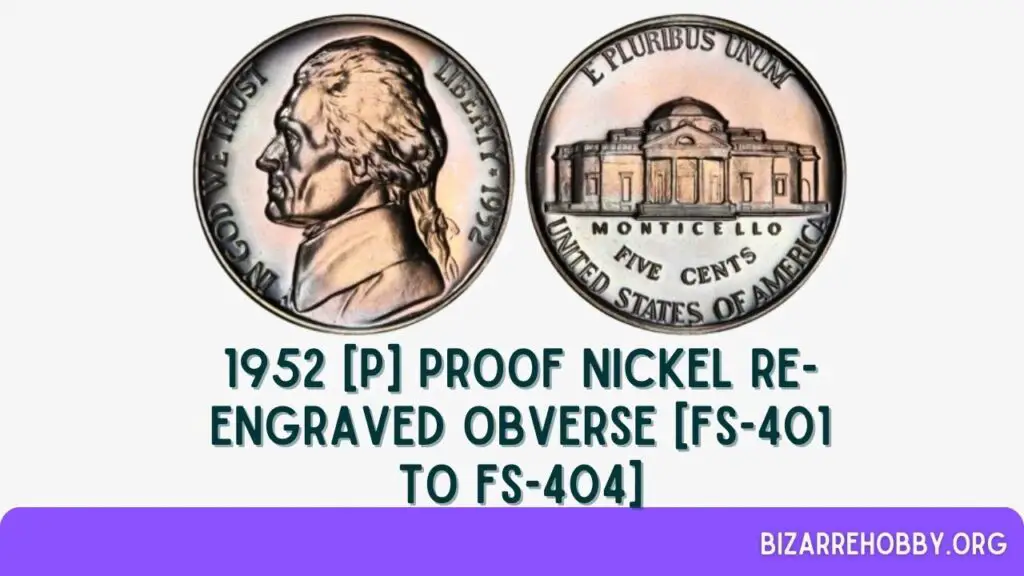
This category isn’t a traditional error but rather a set of four new varieties created when a mint worker attempted to refresh an aging proof die in Philadelphia. For instance, an FS-401 PR 68 sold for $495 in 2019, while an FS-402 PR 67 fetched $378 in 2021.
An FS-403 PR 68 was valued at $600 in 2018, and an FS-404 PR 68 sold for $500 in 2019. An FS-404 PR 68 DCAM reached $1,850 in 2021.
1952-D Nickel Broad-struck Cleaned
The retaining collar or rim ensures coins maintain uniform size, thickness, and weight. Occasionally, the rim is widened or flattened by the dies, resulting in a broadstruck error. Despite its MS 60 grade, this particular coin is valued at only $70 due to the detrimental impact of cleaning on its resale value.
1952 [P] Nickel Broken Planchet – 2 Pieces
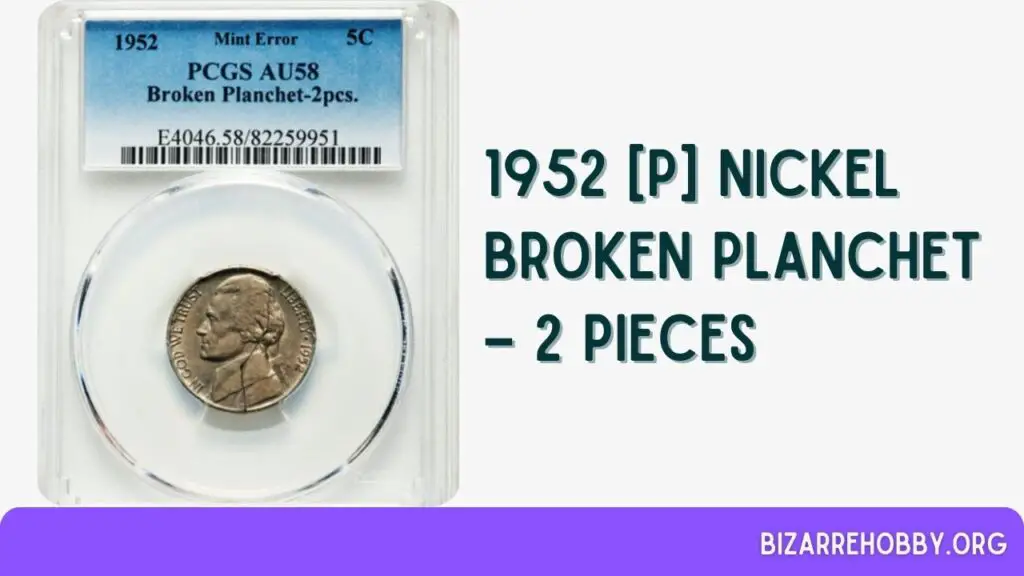
This intriguing error likely occurred due to pre-existing damage to the blank. When struck by the die, the planchet split into two pieces, resembling a jigsaw puzzle. The value increases if both pieces are found and kept together. In AU 58 grade, these paired coins sold for $180.
1952 [P] Nickel Double Struck 90% Off-Center
Coins are typically struck multiple times to ensure detail clarity. Occasionally, a coin is struck again as it exits the press, causing overlapping images and potential shape distortion. A 1952 Nickel with a 90% off-center double strike in MS 62 grade sold for $190.
1952-S Nickel Struck 50% Off-Center
Off-center errors occur when the blank shifts before the die strikes it, leaving part of the surface unmarked. This 1952-S Nickel, struck 50% off-center and graded MS 64 FS, sold for over $440 due to its condition.
1952 [P] Nickel Struck on a Dime Planchet
Occasionally, a coin is struck on a blank intended for another denomination. This 1952 Nickel was struck on a dime planchet, resulting in a smaller size (17.91mm instead of 21.21mm) and a weight of 2.4g instead of 5g. Some design details were truncated. Even in AU 55 grade, it sold for $470.
1952 [P] Nickel Struck on a Penny Planchet
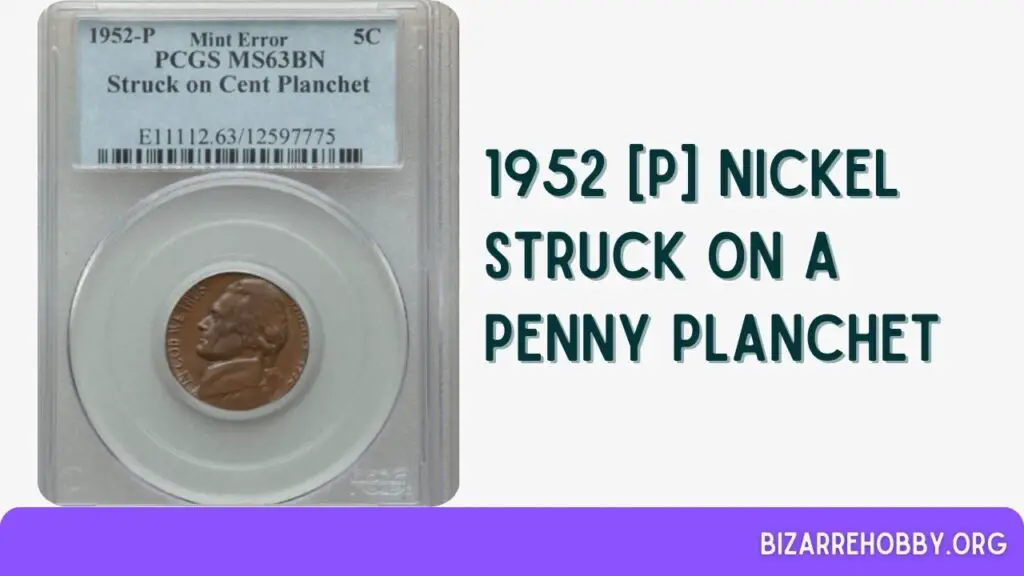
In this error, the nickel was struck on a 95% copper planchet meant for a penny. The reddish copper color makes this mint mistake easily recognizable. Pennies are 19.05mm across, compared to nickels at 21.21mm, leading to truncated design details. Graded MS 63 BN, it sold for $600.
1952 Nickels Split After Strike – Two Pieces
Low-quality coins with unusual errors can be more valuable when sold as a batch. These pieces split edgewise after striking, showing clear designs on one side and jagged surfaces on the other. Despite being graded a low XF 40, they sold for $322.
1952 [P] Nickel Clamshell Lamination Error
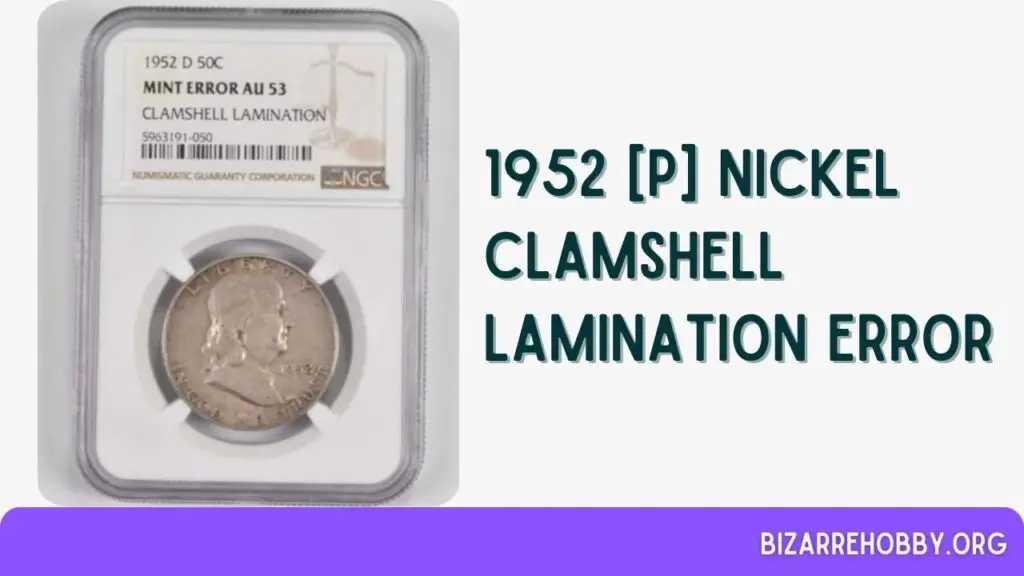
Planchets made of mixed metals are often cast in layers. When struck, some layers may peel or scrape off, revealing a different metal underneath. This type of lamination error is known as a clamshell. Even in a super-low grade of F 15, this coin is valued at $35.
Where to Sell Your 1952 Nickel?
Now that you have a good understanding of your 1952 Nickel’s value, the next step is finding the right platform to sell it. Here are some of the best places to sell coins online, along with their introductions, pros, and cons.
What to look for in 1952 Nickel?
When evaluating a 1952 Nickel, several key factors can significantly impact its value:
- Mint Mark: Check for the presence of a mint mark. Nickels from Philadelphia have no mint mark, while those from Denver and San Francisco are marked with a “D” and “S,” respectively. The mint location can influence the coin’s rarity and value.
- Condition and Grade: The coin’s condition is crucial. Coins are graded on the Sheldon Scale from 1 (Poor) to 70 (Mint State). Higher-grade coins, especially those with Full Steps (FS) on the Monticello building, are more valuable.
- Errors and Varieties: Look for any mint errors or unique varieties, such as double strikes, off-center strikes, or planchet errors. These anomalies can make the coin more desirable to collectors.
- Full Steps (FS): Coins with clearly defined steps on Monticello are considered premium. The more steps visible, the higher the grade and value.
- Proof Coins: Proof coins, especially those with Deep Cameo (DCAM) or Ultra Cameo finishes, are highly sought after. These coins have a mirror-like finish and are struck with special dies.
FAQs On 1952 Nickel coin
Is a 1952 Nickel All Silver?
No, the 1952 Nickel is composed of 75% Copper and 25% Nickel. The only modern nickels that contain silver are the Wartime Nickels minted from 1942 to 1945, which are 35% Silver.
Final Thoughts
Understanding the value of your 1952 Nickel involves more than just knowing its mint mark and condition. By paying attention to details like Full Steps, mint errors, and proof finishes, you can better assess its worth.
Whether you’re a seasoned collector or a novice, these insights will help you make informed decisions about buying, selling, or appraising your 1952 Nickels.
